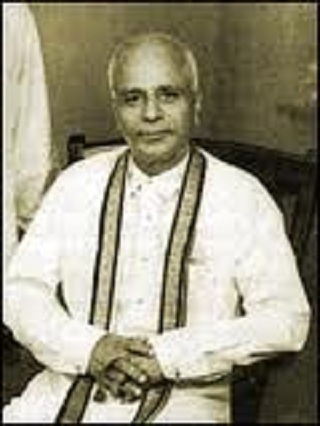
Musiri Subramania Iyer (Musiri) was one of the titans of Carnatic music in the first half of the 20th century. He was an exemplary musician, a highly respected teacher, and a man of character and dignity. Musiri was born on 9th April 1899 at Bommalapalayam village in Tiruchi District as the second child of Sankara Sastry and Seetalakshmi. He lost his mother when he was a baby. His only sister died young. He had his initial training in music, for about three years, under one Narayanaswamy Iyer. Later, he moved to Madras and trained under T.S. Sabhesa Iyer, a stalwart of Carnatic music and a direct disciple of Maha Vaidyanatha Iyer. The training lasted nine years. He thus became a scion of the Tyagaraja sishya parampara. It was from Sabhesa Iyer that Musiri mastered the art of niraval. Musiri married Nagalakshmi in 1913. His first concert in Madras was in 1920 at Triplicane. It is said that it was in that concert that his name was announced for the first time as ‘Musiri’ Subramania Iyer (even though he did not hail from that place). And the name stuck. His father passed away in 1925. Four years later his elder brother also died, leaving behind his widow and three children. Musiri, who had no children of his own, took them under his care. Musiri made rapid progress in his career and, by the early 1930s, became a well known and well earning concert musician. He cut several 78 rpm ‘plates’, which brought him name and fame. His bhava-laden singing of kriti-s and his superb creativity in the niraval segment made him immensely popular with rasika-s.
In 1932 he made a concert tour of the country. He also toured Ceylon, Burma and Malaya, gave charity concerts and raised funds for the Ramakrishna Mission. He acted in the film Tukaram in the title role. His songs in that film made him popular all over Tamil country. The best part of Musiri’s singing career lasted for about 15 years, from 1930 to 1945. He had all the leading violinists and percussionists of the time as his accompanists. He was intimately associated with the Tyaga Brahma Mahotsava Sabha in Tiruvaiyaru from the mid-1930s. Musiri played a prominent role in the unification of the factions of musicians who were conducting the aradhana separately. He was the secretary of the Sabha from 1941-45 (and again in 1966-68), and its vice president during 1955-59. It was during his period that the Sabha observed Tyagaraja’s death centenary in 1947 and celebrated the vaggeyakara’s birth bi-centenary in 1967.
When the Central Government established the Central College of Music in 1949 it chose Musiri as its first principal. He served the College with distinction till he retired in 1965. Musiri was decorated with several honours and titles. He was chosen as the President of the Annual Conference of the Music Academy in 1939, and when the Academy instituted the Sangita Kalanidhi title in 1942, Musiri was given the title along with other past presidents. He was one of the youngest musicians to receive it.
In the next year he was appointed Asthana Vidwan of Travancore. He got the central Sangeet Natak Akademi award in 1957, the Isai Perarignar title from Tamil Isai Sangam in 1963 and Sangeeta Kala Sikhamani of Indian Fine Arts Society in 1966. These were followed by two prestigious awards: the Fellowship of SNA in 1967 and Padma Bhushan in 1971. By the end of 1970 his health was causing concern and he needed hospitalisation for about a month. Though he recovered, he had to remain confined to his house for the remainder of his life. He breathed his last on 24th March 1975.
His music
Gifted with a high-pitched voice and tonal purity, Musiri was perhaps most at home in the upper octave.
He was an exponent of ‘bhava music’, bringing out the emotional content of any music he rendered, sometimes with a bit of dramatization for full effect, a la Pandit Omkarnath Thakur.
He was a specialist in the vilamba kala mode of singing, and evocative niraval. He popularised many Tamil
songs. Some of the pieces Musiri sang often (and which were not generally handled by other musicians then) were: Endu daaginaado (Todi, Tyagaraja), Ninnu minchina (Natakurinji, Patnam Subramania Iyer), Entani ne delupudura (Khamas varnam, Subbarama Dikshitar), Daani samajendra (Todi varnam, Musiri believed that classical music should have melodious appeal as well as technical perfection. Both sahitya and sangeeta are important and an exponent should strive to strike a harmonious balance between the two. Sangita Kalanidhi Musiri Subramania Iyer was a Carnatic vocalist of soulful melody.


